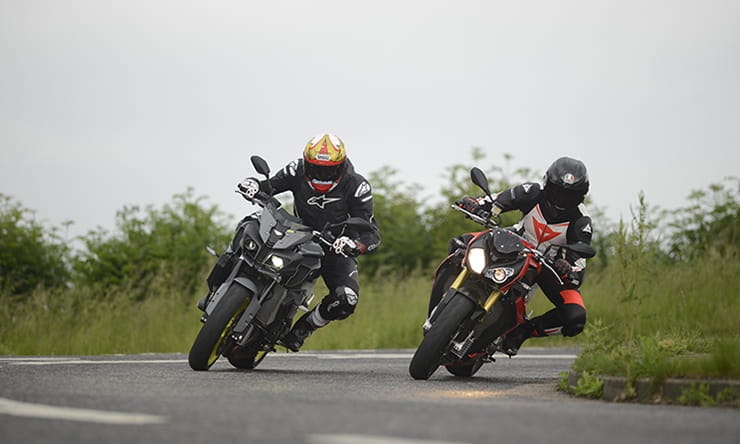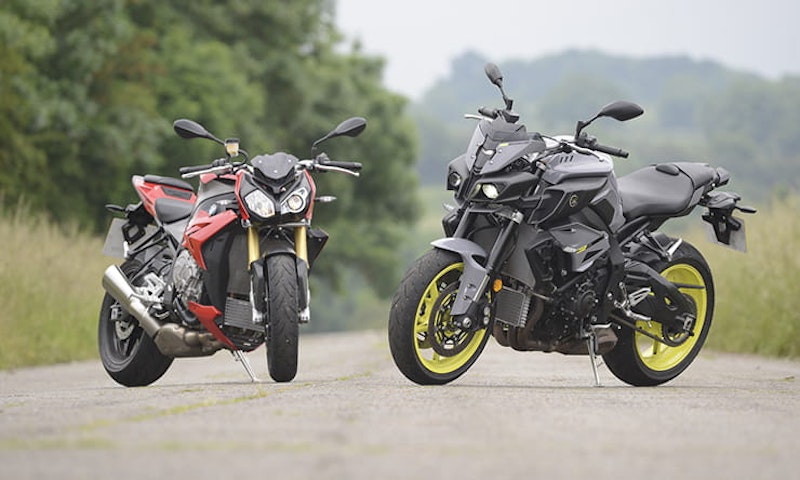Yamaha MT-10 vs BMW S1000R: Naked Ambition
By Michael Mann
BikeSocial Managing Editor
11.07.2016
“Revs your heart” says Yamaha’s marketing gubbins about its MT range, which stands for ‘Masters of Torque’ by the way.
They’re not wrong. About either. And if you’re reading this, there’s a good chance you’ve already read one if not many of the glowing reviews of just how epic the MT-10 is. That’s once you’ve made your mind up about its looks of course; hard as nails or Johnny 5 meets Optimus Prime? Either way, with its very attractive price the Yamaha surely has one wheel on the ‘Bike of the Year’ award.
Forget Prozac, forget caffeine, Dr. Mann prescribes a hearty 158.3 bhp dose of MT-10 for a full factory spec, energy bursting, heart pounding hit of bad ass power to awaken the senses and put a spring in your step.
The new kid on the sports naked block was vaunted as the ‘naked R1’ when first announced, although at first Yamaha teased us all by offering limited details, deliberately no power nor price – two of the key features for building interest. Would it rival the phenomenal Aprilia Tuono V4 or KTM’s mad 1290 SuperDuke each with their 180bhp or were we looking at the 160bhp Ducati Monster 1200 or 138bhp Triumph Speed Triple R as its closest competitor?
As near as some of those four may seem with their specs, power or price, we reckon the MT-10 has come straight for BMW’s supremacy in the market with their two-year old S1000R. But the shocker wasn’t really the match in power and torque figures, it was the £1350 lower price tag of the new Yamaha.
As soon as the first MT-10 stock landed in the UK, we grabbed the nearest S1000R and headed for a multi-part, head-to-head test on the B-roads, at Silverstone on the full Grand Prix circuit and for a round of performance testing with datalogging equipment at Bruntinghtorpe airfield. And it could not have been closer. We’re talking tenths, if not hundredths of a second between some of the measures.
Like being trusted to keep a massive secret and wanting to just blurt it out, I can’t write anymore without waxing lyrical about just how awesome the MT-10’s crossplane, 270 degree, 4-stroke, 4-cylinder, 998cc engine is. It is Yamaha’s not-so-secret weapon and within 60 seconds of riding the Yamaha you too will understand this is something a) special, b) different, and c) worth riding. When a bike shows you a loveable character instantly, like a Labrador puppy wagging its tail and licking your hand, you can’t fail to smile. The torque curve peaks at 82 ft-lbs at 9000 rpm but realistically anywhere from 4,000 – 10,000 rpm and the Yamaha has a deep spread of power alert and ready, driving you hard out of corners as you clip the optional extra quickshifter through the gears. It’s well worth spending £200 on by the way. Yamaha say the airbox is larger on the MT than the R1 hence the benefit in the midrange.
And while the Yamaha is all leapy and excitable from low-range into and across the mid-range, it’s here where the BMW takes over. The two bikes are virtually identical in their performance figures from 0-60mph with the S1000R edging it by 2/100ths of second according to our GPS datarecording figures. However, the BMW shows it’s grunt higher up the rev range when asked to go all the way to 100mph (at Bruntingthorpe airfield) when it gets there over ½ second faster than the Yamaha.
The German entrant of the duo is the more refined in terms of the quality of finish and also the power delivery. Still an absolute peach of a bike two years after its debut and it still out-equips most other supernakeds with the quickshifter (or Gear Shift Assist Pro as BMW call it) plus clutchless downshifts. There’s electronic suspension which is the other feature on the Sports model plus rider modes, wheelie control and of course, traction control. Which is where the difference between prices ends up.
Both bikes also have cruise control – a pre-requisite along with gear shift indicator on all new 800cc+ bikes as far as I’m concerned. The BMWs system is identical to all its other models; the on/off slide switch is then actioned by flicking an adjacent switch forwards or backwards. On the Yamaha the operations are also located on the left-side of the bars although the large up/down rocker switch is above a simply on-off button.
Neither throttle is too snatchy or obnoxious just simply there with power on demand with the slightest hint of throttle movement. I felt alive because the bike felt alive. Just as alive as the brakes in fact. Both have hydraulic twin 320mm discs on the front that coupled with the KYB forks on the Yamaha and the more technically advanced and adaptive electronic suspension on the BMW are both stable and hugely competent should the excitable Labrador bound into the road ahead. The BMW managed to stop dead from 70mph in just 3.3 seconds, 0.4s quicker than the MT-10.
ON TRACK
Pootling down the pit lane ahead of the first session on the Grand Prix circuit at Silverstone’s bike track day and the anticipation of unleashing every single one of the Yamaha and the BMWs brake horses is a nice feeling, particularly when surrounded by heroes on their purpose-built machines.
Despite the Bridgestone Battlax S20R tyres not being ideal for such purposes, they hold up well enough to test the other attributes such as the sportsbike motor in its more road-relevant chassis.
Give it a lap to warm everything up and by the time you’re accelerating out of The Loop, a slow second gear left-hand hairpin and short-shifting into third for Aintree before powering down the Wellington Straight, the MT-10 drives hard, sitting down at the rear with its softer and more road-oriented rear shock. The front wheel wants to lift, admittedly less so with the throttle cranked open in third, fourth and even fifth. Pushing back in the seat against the small mound in between the rider and pillion helps find the ideal position. The 998cc four-stroke howls beautifully as the MT-10 covers ground quickly, smoothly and noisily. Hard on the brakes and down two gears and lean it over searching for late apex at Brooklands, the Yamaha behaves impeccably.
The MT-10 will max out at, or rather is restricted to, an indicated 164mph (which according to our datalogger is actually 150mph) but as I’ve said, it’s lower down in the rev range where the Yamaha’s performance excels.
It's almost like the BMW takes over from where the Yamaha runs out of steam - its performance is epic yet conservative because rather than shouting about it, the S1000R just gets on with accelerating harder, faster and with a little more stability thanks to its chassis and clever dynamic suspension set-up. The quickshifter is both precise and fast, requiring the slightest touch to feel the pop of another gear being engaged. A lower seat height and longer wheelbase aid stability and offer a slightly sportier riding position. Neither of these two were designed for lap record pace, their engines might be have a sports-based heartbeat but their road-going bodies have more comfort in mind. Fellow tester, Marc Potter, and I agree that if push came to shove, the BMW would win a race.
Share on social media:

